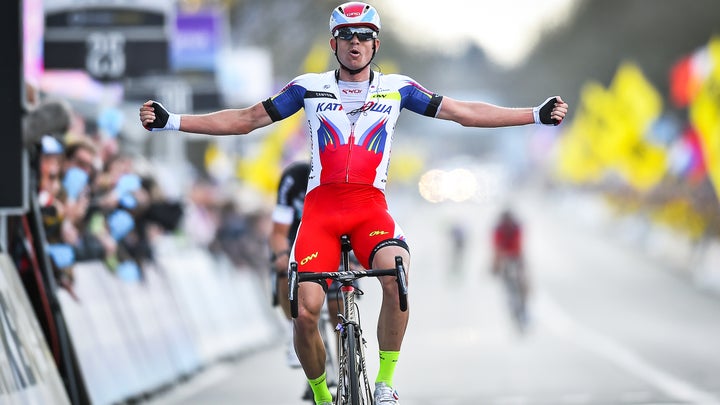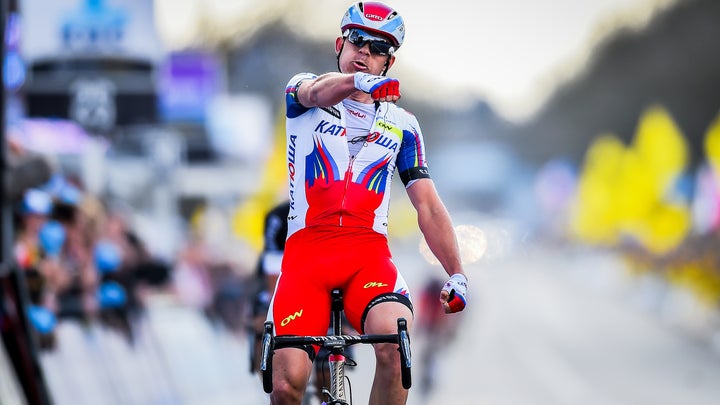Heading out the door? Read this article on the new Outside+ app available now on iOS devices for members! Download the app.
Established in 2012, the new-look Tour of Flanders route, with its finishing loops up the Oude Karemont and the Paterberg, was not an immediate success. One of the most exciting aspects of it in recent years is its unpredictability. The winning move does not just happen on the last climbs.
The victory by Alexander Kristoff in 2015 proved to be nothing less than a watershed victory, as the Norwegian broke away with Dutch rider Niki Terpstra, nearly 30 kilometers from the finish. A classic road sprinter, Kristoff rarely wins in a breakaway. But things were different in Flanders that year. VeloNews caught up with Kristoff, to look back on a memorable victory, the one he considers his greatest.
VeloNews: Alexander, in our weekly podcast, we each picked one Tour of Flanders that stood out, and I picked your victory in 2015, because for me it was a real watershed moment. Your victory was the first on the new course that did not come down to the last time up the Oude Kwarement or Paterberg. You were the first to win on the new route by attacking much earlier, and it was not the last time such a move succeeded. So, I thought it would be great to talk with you and look back on that historic win.
Alexander Kristoff: Oh cool. Well it was definitely a very memorable day for me. Flanders has always been such a special race. Even before my victory, I felt like I could do something special in Flanders. And even after winning it, I think I have been in the top five every year, except 2018. Last year I was third and I think every other year, except my very first year, I was in the top five.
VN: I remember talking to you after your victory in Milano-Sanremo. We talked about the cobbled classics you hoped to win, and I remember very distinctly that you said that, despite your size, you thought you had a better chance of winning the Tour of Flanders than Paris-Roubaix. I was surprised because I thought the flatter profile of Roubaix would suit you better. But you said no, Roubaix was like a long time trial, while the short, steep hills in Flanders were more like a series of sprints.
AK: Yes, most definitely, the climbs really suit me. Sure the climbs are steep and very hard, but they are generally relatively short and so I can get over them. And then I think also, the sheer distance of the race suits me because I am usually good in longer races. Also I had finished fifth the year before, and fourth the year before that, so I really felt that victory was possible one day. In addition, I was having the best start of my season ever. I think I had won eight races already, and at the Three Days of La Panne, the week before, I won pretty much everything except the time trial. I won the [general classification] as well. So I knew my shape was really good! I also knew I had a good team, as Luca Paolini had won Ghent-Wevelgem the week before. So we came into race thinking we could win it.

But that said, during the race, we didn’t really feel like we had the race under control. And I didn’t feel very good on the first climbs. But it didn’t get worse. And then the second time up the Kwaremont, I wasn’t feeling so bad, and things started to turn around.
VN: You attacked with Niki Terpstra nearly 30 kilometers from the finish. Did you think that this could really be the winning move, or were you just covering what you considered to be a dangerous move, and perhaps forcing a selection with a small group?
AK: Well it is interesting, because I went away with Terpstra the year before, but that time we were chasing the leaders. I knew he was strong. That said, I didn’t really think it was the decisive move and that we would stay away until the finish. But I thought a couple of others would come up to us, and then we would really fight for the win later in the race. Also, I thought that it came into the final with an advantage, then it would be easier to survive the Kwaremont and the Paterberg the last time up. So when I went, I thought it was a good move. And in the end, nobody came up to us, so it was the decisive move. And because I was faster than Terpstra, at least on paper, I knew that if I could stay with him on the final climbs, that I could probably win.
VN: Well Quickstep so often has the power of numbers on their side in the classics, and I remember thinking that they were just sending him up the road to set up a bigger move later on.
AK: Well perhaps. But also you have to remember that neither Tom Boonen nor Fabian Cancellara were in the race that year, and it was just before guys like Greg Van Avermaet and Peter Sagan really came into their own as classics riders. So there was a little bit of a vacuum that year and I took advantage of it.
VN: Well it is always interesting to see just how hard it can be to close gaps in the classics. You guys never had a huge gap—30 seconds at most—but it was just enough, because somebody was going to have to make a big effort to close it. And if a rider doesn’t have any teammates left, well then it is one of the big riders that has to make that effort. And if they can’t jump across clean, then they simply risk setting themselves up for a counter-attack. Were you thinking about this as the kilometers ticked away?
AK: To be honest, I didn’t think so much — I was just trying to survive! But once we got over the Paterberg, I knew that it was going to be hard for anyone to catch us. Once again, the year before, I was chasing, and it was impossible to bring the gaps down. I could see Cancellara’s group in front of me, but with all of the motorbikes and cars, well I just couldn’t close the gap. There are a lot more motorbikes in front of the leaders, and even if you are not drafting per se, you are still getting an advantage. When there are five or ten motorbikes in front of you, well you are still getting some draft. And behind, the chase group has maybe just one moto. So I knew that it was for sure better to be in front.
VN: I am always surprised because there is a long flat run-in to the finish after the Paterberg—almost 15 kilometers—but so often, if someone gets a small gap on the Paterberg they manage to stay away.
AK: Well for one, if you can get ten seconds on the Paterberg that means you still have some power left and that you are the strongest.
VN: Well looking back, you were actually the strongest on the Paterberg. Terpstra tried to accelerate, it seemed, but you actually came around him and it looked like, at the summit, like Terpstra was struggling to hold your wheel.

AK: Well first he tried to drop me on the Kwaremont and I was struggling a bit there. But the Kwaremont is much longer, and so for me it is just a much harder climb to negotiate. The Paterberg is much better for me because, although it is steeper, it is shorter. I actually felt good on the Paterberg.
VN: Well by the time you got to the sprint, you made it look easy. I mean you not only led it out, but you just powered away from Terpstra.
AK: Well he knew that in a sprint he could not beat me, so he could not lead it out. But once he could not drop me on the Paterberg, well, he knew that he had to attack me somewhere. But that day I was just very strong. And even when I was pulling, I kept looking over my shoulder so he couldn’t take me by surprise.
VN: Well you have obviously had a lot of great wins in your career and with Sanremo and Ghent-Wevelgem, three major victories. How does Flanders resonate looking back?
AK: Well for me it is surely the victory I am most proud of. It is just a race I love to watch, and I have always loved [it]. And it is in Belgium, where cycling is just so popular and where there is so much history. Obviously it is hard to compare. Sanremo was my first really big victory — my first monument. But the way I won Flanders, was very special for me. It’s not often that I have won a race in a breakaway. It was just very special.
You know, I have one trophy up in my living room. It is the Flanders trophy. The rest are down in my office. But I have a special place in my house for that one.